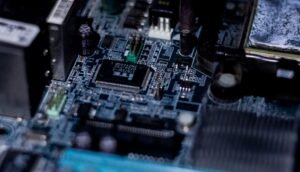Learning AI Robot
Artificial Intelligence (AI) has made tremendous advancements in recent years, and one of the most exciting developments is the creation of learning AI robots. These robots are designed to acquire knowledge and skills through interaction with their environment using machine learning algorithms. They have the potential to revolutionize various industries, from manufacturing to healthcare.
Key Takeaways:
- Learning AI robots can acquire knowledge and skills through interactions with their environment.
- They use machine learning algorithms to continuously improve their performance.
- These robots have applications in various industries, including manufacturing and healthcare.
Learning AI robots are designed to continuously acquire new information and refine their capabilities through machine learning. They are able to analyze, interpret, and apply the gathered data to enhance their decision-making processes and task execution. This iterative learning approach enables them to adapt to changing conditions and improve their overall performance over time. It’s like a perpetual learning cycle that enables them to become increasingly efficient and accurate.
One of the key components that make learning AI robots effective is their ability to gather data from their environment. They rely on various sensors, such as cameras, microphones, and touch sensors, to perceive their surroundings. This data is then processed using machine learning algorithms, allowing the robots to recognize patterns, make predictions, and take informed actions. By constantly sensing and analyzing their environment, they can adapt to new situations and perform complex tasks with precision.
Learning AI Robot Applications
Learning AI robots have a wide range of applications across different industries. They have the potential to automate tasks that are repetitive, time-consuming, or dangerous for humans. Some notable applications include:
- Manufacturing: Learning AI robots can streamline production processes, optimize quality control, and perform tasks that require dexterity and precision.
- Healthcare: These robots can assist in patient care, perform surgeries with high precision, and aid in medical research by analyzing vast amounts of data.
- Education: Learning AI robots can personalize the learning experience for students, providing tailored instruction and feedback based on individual needs.
- Service Industry: Robots can be used in service-oriented industries such as hospitality and retail to provide personalized customer service and automate routine tasks.
Challenges and Limitations
While learning AI robots have great potential, there are still challenges and limitations that need to be addressed. Some of the key challenges include:
- Data Privacy: Collecting and storing large amounts of data raises concerns about privacy and security.
- Algorithm Bias: Machine learning algorithms can exhibit biased behavior if not properly trained or supervised.
- Human-Robot Interaction: Ensuring effective communication and collaboration between humans and robots can be a complex task.
- Ethics and Legal Concerns: As robots become more autonomous, ethical and legal considerations emerge regarding their decision-making capabilities and accountability.
Overview of Learning AI Robot Types
| Type | Description |
|---|---|
| Reinforcement Learning Robot | Learns through trial and error, receiving feedback from its environment to enhance performance. |
| Supervised Learning Robot | Learns from labeled examples and seeks to generalize from its training data. |
| Unsupervised Learning Robot | Discovers patterns and relationships in data without being given explicit guidance or labeled examples. |
Learning AI robots have the potential to revolutionize industries, enabling automation, improving efficiency, and enhancing decision-making processes. These robots continuously learn and adapt, making them invaluable assets in various fields.

Common Misconceptions
Misconception 1: AI Robots are capable of human-like emotions
One of the common misconceptions about AI robots is that they are capable of experiencing human-like emotions. While AI technology has made significant advancements in the past years, robots still lack the complexity and depth of emotions that humans possess.
- AI robots can only simulate basic emotions such as happiness or sadness.
- Robots cannot feel joy, sorrow, or empathy like humans do.
- Their perceived emotions are programmed responses based on algorithms.
Misconception 2: AI Robots will replace human jobs completely
There is a misconception that AI robots are a threat to human employment and will eventually replace all jobs. While it is true that AI technology can automate certain tasks, it is unlikely that robots will completely replace human workers in all industries and sectors.
- AI robots are more likely to augment human work rather than replace it entirely.
- Robots are better suited for repetitive and mundane tasks, leaving humans to focus on more complex and creative aspects of work.
- Jobs that require human judgment, emotional intelligence, and creativity are harder to replace with AI robots.
Misconception 3: AI Robots are infallible and always make the right decisions
Another misconception is that AI robots are perfect decision-makers and never make mistakes. However, the reality is that AI systems are only as good as the data and algorithms they are trained with and can still make errors.
- AI robots can be biased based on the data they are fed, leading to biased decisions.
- They can struggle with complex or ambiguous situations that require human judgment.
- AI robots still lack common sense and may make illogical decisions in certain scenarios.
Misconception 4: AI Robots are autonomous and can function independently
Many people assume that AI robots are fully autonomous and can function independently without any human intervention. However, most AI robots require human supervision and guidance to operate effectively.
- AI robots rely on human programmers and trainers to set goals and objectives.
- They require continuous human monitoring to ensure they are functioning correctly.
- Robots may encounter situations they are not programmed to handle and need human assistance.
Misconception 5: AI Robots are only futuristic machines
Some individuals believe that AI robots are only fictional machines depicted in futuristic movies. However, AI robots are already present in various industries and have practical applications in our everyday lives.
- Robots are used in industries like manufacturing, healthcare, and agriculture to improve efficiency and productivity.
- Chatbots and virtual assistants powered by AI are becoming increasingly common in customer service roles.
- AI robots, such as autonomous vehicles, are being developed and tested for future transportation.

The Evolution of AI
The table below shows how artificial intelligence has evolved over the years. It highlights the significant milestones and breakthroughs achieved in the field.
| Year | Event |
|---|---|
| 1956 | Dartmouth Conference: The birth of AI |
| 1997 | IBM’s Deep Blue defeats world chess champion Garry Kasparov |
| 2011 | IBM’s Watson wins Jeopardy! against human contestants |
| 2012 | Google’s DeepMind develops a neural network to recognize images |
| 2016 | AlphaGo defeats world Go champion Lee Sedol |
| 2019 | OpenAI’s GPT-2 generates realistic text |
The Rise of Robotics
This table showcases the growing presence of robotics in various industries. It highlights the sectors in which robots are being employed and their contributions.
| Sector | Applications | Contributions |
|---|---|---|
| Manufacturing | Assembly line automation | Improved productivity and efficiency |
| Healthcare | Surgical robots, patient care | Precision, reduced medical errors |
| Agriculture | Harvesting, crop monitoring | Increased yield, reduced labor |
| Transportation | Autonomous vehicles | Improved safety, reduced congestion |
| Space Exploration | Rovers, satellite deployment | Unprecedented exploration capabilities |
The Impact of AI on Job Market
This table showcases the potential effects of AI on various job sectors. It presents current and projected job displacement due to automation.
| Sector | Jobs at Risk | Projected Displacement (%) |
|---|---|---|
| Transportation | Truck drivers | 79% |
| Retail | Store cashiers | 73% |
| Manufacturing | Factory workers | 58% |
| Agriculture | Farm laborers | 45% |
| Customer Service | Call center agents | 32% |
AI in Daily Life
This table explores the integration of AI in our daily lives. It highlights the applications of AI that impact us on a regular basis.
| Domain | AI Applications |
|---|---|
| Smartphones | Virtual assistants, facial recognition |
| Entertainment | Recommendation systems, personalized content |
| Health and Fitness | Activity trackers, personalized recommendations |
| Home Automation | Smart thermostats, voice-controlled assistants |
| Education | Intelligent tutoring, adaptive learning |
The Quest for AGI
This table chronicles the development of Artificial General Intelligence (AGI) and the organizations involved in its pursuit.
| Organization | Contributions |
|---|---|
| OpenAI | Promoting AGI safety and responsible development |
| DeepMind | Advancements in reinforcement learning, ethical AI |
| Google Brain | Research in deep learning, neural networks |
| Facebook AI | Development of open-source AI tools, algorithms |
| MIT AI Labs | Interdisciplinary AI research, collaboration |
AI’s Ethical Dilemmas
This table highlights the ethical concerns and dilemmas associated with AI and its wide-scale implementation.
| Issue | Implications |
|---|---|
| Privacy | Data breaches, surveillance concerns |
| Job Displacement | Unemployment, economic inequality |
| Algorithmic Bias | Discrimination, unfair decision-making |
| Autonomous Weapons | Legal, ethical, and safety ramifications |
| AI Regulation | Establishing responsible guidelines and oversight |
The Human-AI Collaboration
This table showcases the potential of humans and AI working together to achieve enhanced results in various fields.
| Collaboration | Field | Advantages |
|---|---|---|
| Disease Diagnosis | Healthcare | Improved accuracy, faster diagnoses |
| Art Creation | Arts and Creative Industries | Novel ideas, expanded creativity |
| Financial Analysis | Finance | Data processing, risk assessment |
| Weather Forecasting | Meteorology | Precision, real-time predictions |
| Space Exploration | Aerospace | Deep space analysis, mission planning |
The Future of AI
This table speculates about the potential future advancements in AI and the impact they might have in different sectors.
| Advancement | Sector | Potential Impact |
|---|---|---|
| Autonomous Vehicles | Transportation | Reduced accidents, improved traffic flow |
| Medical Diagnosis | Healthcare | More accurate and early detection of diseases |
| Language Translation | Communication | Instant and accurate global language translation |
| Robotic Assistance | Manufacturing | Enhanced collaboration between humans and robots |
| Space Colonization | Space Exploration | Establishment of human settlements on other planets |
Artificial intelligence and robotics have revolutionized numerous industries and are becoming increasingly integrated into our daily lives. Through AI’s evolution, from seminal events in the 1950s to recent achievements like OpenAI’s GPT-2, the potential of these technologies has grown immensely. The rise of robotics and their diverse applications, ranging from manufacturing to healthcare, has transformed traditional practices and yielded remarkable results. However, this progress has sparked concerns about job displacement across various sectors. AI’s expanding presence is evidenced by its integration into domains like smartphones, entertainment, and education, enhancing user experiences. As organizations such as OpenAI, DeepMind, and Google Brain strive for the development of Artificial General Intelligence (AGI), ethical dilemmas and the need for regulation have also emerged. Nevertheless, the collaboration between humans and AI in fields like healthcare, finance, and meteorology demonstrates the potential for synergistic outcomes. The future of AI holds remarkable promise, envisioning advancements in autonomous vehicles, medical diagnoses, language translation, robotic assistance, and even space colonization.
Frequently Asked Questions
What is an AI robot?
AI stands for Artificial Intelligence. An AI robot is a machine that is capable of learning and making decisions based on the data it receives from its surroundings.
How does an AI robot learn?
An AI robot learns through a process called machine learning. It analyzes data, identifies patterns, and uses the information to make predictions or take actions.
What can an AI robot be used for?
An AI robot can be used in various fields such as healthcare, manufacturing, customer service, and education. It can assist with tasks, provide information, or even interact with humans.
Is it possible to teach an AI robot new skills?
Yes, an AI robot can be trained to acquire new skills. With the help of machine learning algorithms, it can learn from new data and adapt its behavior accordingly.
What are the advantages of using an AI robot?
Using an AI robot can lead to increased efficiency, improved accuracy, and cost savings. It can perform tasks that are too dangerous or time-consuming for humans.
Are there any ethical concerns regarding the use of AI robots?
Yes, there are ethical concerns associated with AI robots. Issues like privacy, job displacement, and biased decision-making algorithms need to be considered and addressed.
Can an AI robot replace human workers?
An AI robot can perform some tasks that were traditionally done by humans, but it is unlikely to completely replace human workers. Instead, it can augment human capabilities and improve productivity.
How do AI robots utilize natural language processing?
AI robots use natural language processing (NLP) techniques to understand and respond to human language. They can process and interpret text or speech, allowing for human-like interaction.
What is the difference between weak AI and strong AI?
Weak AI, also known as narrow AI, is designed to carry out specific tasks and is limited in its capabilities. Strong AI, on the other hand, refers to a system that is capable of human-level intelligence and is often hypothetical.
How can I get started with learning AI robotics?
To get started with learning AI robotics, you can explore online courses, tutorials, and books on topics such as machine learning, robotics, and programming. Experimenting with AI development platforms and tools can also help in gaining practical knowledge.




